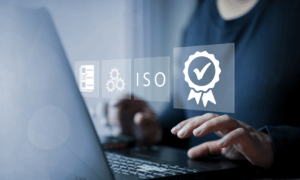For service organizations that process transactions, manipulate data or store financial information on behalf of their customers, a SOC 1 (short for Service Organization Controls) report provides assurance that the processing of those transactions and data is done consistently and can be relied upon by your customer, and even more relevantly, your customer’s auditors.
What Is a SOC 1 Report?
A SOC 1 examination centers on the internal controls over financial reporting (ICFR) a service provider has in place to ensure transaction processing or data manipulation is done consistently and reliably. The SOC 1 standard is established and maintained by the American Institute of Certified Public Accountants (AICPA) and the examination is typically conducted by auditors from an independent accounting firm.
SOC 1 engagements require specialized auditor skills, including understanding the relevant standards as well as the business processes of their clients. The auditor provides an opinion upon completion of a SOC 1 engagement with the objective of a successful engagement offering a “clean” opinion that is attached to the SOC 1 report.
SOC 1 Type 1 vs. SOC 1 Type 2
A SOC 1 report may be completed in one of two forms. A SOC 1 Type 1 report examines the service organization’s ICFR at a specific point in time and provides evidence on whether the controls are designed properly. A SOC 1 Type 1 report is usually done, if at all, on the initial SOC 1 engagement and as a precursor to the SOC 1 Type 2 report.
However, when your customer asks you for a SOC 1 report, they almost invariably mean a SOC 1 Type 2 report. The fundamental difference is that a SOC 1 Type 2 report tests those controls and their performance over a period such as six months or a year. As such, the SOC 1 Type 2 not only covers whether the controls are properly designed; the controls are also tested to determine if they are operating effectively over the relevant period. SOC 1 Type 2 engagements are by far the most common report, with most covering one year.
SOC 1 vs. SOC 2
SOC 1 and SOC 2 reports have some overlap, but there are fundamental differences with SOC 1 vs. SOC 2.
A SOC 2 report reviews the controls that address the Trust Services Criteria (primarily security, but there are five criteria to choose from) and is relevant for service organizations that have custody of their customer’s data. The Trust Services Criteria provide a framework that can be applied to a wide range of service providers.
On the other hand, a SOC 1 report is focused on business processes specific to the service organization and thus there is significantly more variability because the control environment, and the related controls, will be specific to the service organization.
The testing procedures for a SOC 1 will focus on financial controls and transaction processing, while a SOC 2 will examine general IT controls (ITGC) testing and validation. This is where the overlap comes in. As most SOC 1 systems are built on information technology systems, many controls from a SOC 2 report can be mapped to a SOC 1 report.
Depending on the industry a service organization serves and its customer expectations, a provider may need to obtain both types of reports. If so, there can be efficiency and cost benefits to undergoing both types of audits at the same time.
Who Needs a SOC 1 Report?
Because a SOC 1 report is focused on financial reporting controls, it’s best suited for organizations that process or store financial data on behalf of their customers. Typical types of service organizations that may need a SOC 1 include:
- Software-as-a-Service (SaaS) providers that process financial data.
- Payment processors.
- Payroll processors.
- Claims processing and billing providers.
- Benefits administrators.
- Collections organizations.
Beyond these organizations, any company that processes or stores financial data for a customer may be asked for a SOC 1 report. Often the request for a SOC 1 report will be generated from your customer’s accounting and finance function, or you may get direct requests from a customer’s financial statement auditors (the intended reader of a SOC 1 report). For more information on who needs SOC 1 reports and why they matter watch the video below.
The Benefits of a SOC 1 Report
Obtaining independent verification that a service organization’s ICFR is performing effectively, known as a “clean” audit report, can provide several benefits such as:
- Ensuring the organization is protecting customer and partner financial information. An audit can verify that the organization’s controls and processes are operating as designed, or it can identify areas that need remediation.
- Demonstrating the organization’s commitment to data security and governance.
- Assuring customers your systems are processing transactions consistently and reliably.
- Identifying opportunities to increase risk management and operating efficiency within your systems and processes.
- Reducing overhead from multiple auditors of your customers asking to meet with you to understand your system and how you process transactions.
Beyond compliance, a clean SOC 1 report can provide compelling benefits in attracting and retaining customers:
- Providing a SOC 1 report is becoming a common contractual requirement, especially among large enterprise customers. These organizations want to ensure their data will be processed consistently and accurately, and increasingly rely on SOC 1 reports for that assurance.
- Obtaining a SOC 1 report can differentiate a service organization from competitors that have not undergone a SOC audit.
- Having a SOC 1 report can help service organizations properly respond to your customers and their auditors’ inquiries as to how your environment reliably processes transactions.
To learn more about SOC 1 reports and the benefits they can provide your service organization, contact us.

















